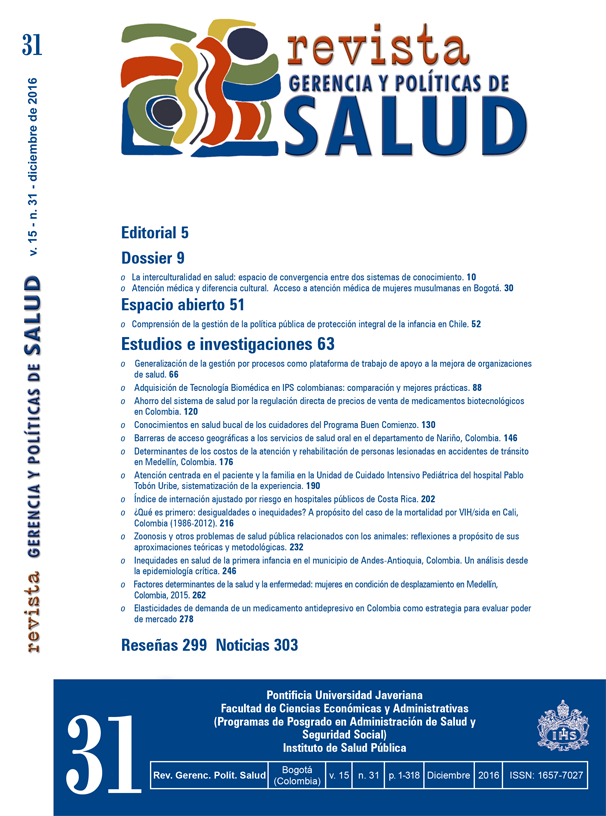Abstract
This article develops an estimation of the price elasticity of demand of a medication “type” for treating depression. This disorder affects physically and mentally a big part of the population around the world. This disorder is considered an important public health problem whose prevalence has been increasing. For the purpose of this research two econometric models of vectors were estimated for the previous period of the issuance of Circular 03 of 2013, which regulates the price of medications in Colombia. The outcomes of the estimation show a non-significant price elasticity of 0.35 %, that is to say, changes in price do not generate the expected response in demand. This result suggests that the company, which produces this type of medication, exerts significant power in the market. Therefore, this result proves the need to implement the Circular.
2. Rodríguez AS, Vásquez VJ, Gómez PK. Regulación en el mercado farmacéutico colombiano. Revista de
Ciencias Sociales. 2010; 16(2):197-209.
3. Circular 03 del 2013. Comisión Nacional de Precios de Medicamentos y Dispositivos Médicos, Colombia.
4. Consejo Nacional de Política Económica y Social, Departamento Nacional de Planeación, Colombia. Documento Conpes Social. Política farmacéutica nacional. Proyecto para discusión. Bogotá: Departamento
Nacional de Planeación; 2012.
5. Machado-Alba JE, Morales Plaza CD, Solarte Gómez MJ. Patrones de prescripción de antidepresivos en pacientes afiliados al Sistema General de Seguridad Social en Salud de Colombia. Rev Panam Salud Pública. 2011; 30(5):461-8.
6. Center for Global Development. A Risky business. Saving money and improving global health through
better demand forecasts. Washington D. C.: Library of Congress Cataloging-in-Publication Data; 2007.
7. Managing Science for Health. MDS-3: Managing access to medicines and health technologies. Arlington,
VA: Management Science for Health; 2012.
8. Ghousi R, Mehrani S, Momeni M, Anjomshoaa S. Application of data mining techniques in drug consumption forecasting help pharmaceutical industry production planning. Proceedings of the 2012 International Conference on Industrial Engineering and Operations Management; 2012 Jul 3-6; Estambul, Turquía. Irán: Iran University of Science and Technology, Narmak; 2012.
9. Ching AT. Consumer learning and heterogeneity: dynamics of demand for prescription drugs after patent expiration. Int J Ind Organ. 2010; 26(6): 619-638.
10. Kim W, Won JH, Park S, Kang J. Demand forecasting models for medicines through Wireless sensor networks data and topic trend analysis. International Journal of Distributed Sensor Networks. 2015; 36.
11. Fisher S, Cockburn I, Griliches Z, Hausman J. Characteristics of demand for pharmaceutical products: An examination of four cephalosporins. Rand J Econ.1997; 28(3):426-46.
12. Hurtado JL, Melo LF. Una metodología multivariada de desagregación temporal. Borradores de Economía del Banco de la Republica. 2010; (586):1-37.
13. Quilis EM. A matlab library of temporal disagregation methods: Summary. Madrid: Instituto Nacional de Estadística; 2004.
14. Flores de Frutos R, Pereira AM. Public capital and aggregate growth in the United States: Is public capital productive? Documentos de Trabajo del Instituto Complutense de Análisis Económico (ICAE). 1993; (13):1-33.
15. Roca O, Pereira AM. Impacto de la inversión en infraestructura sobre el producto, la ocupación y la inversión privada en España. Revista Española de Economía. 1998; 15(3):403-32.
16. Pesaran H, Shin Y. Generalized impulse response analysis in linear multivariate models. Economics Letters. 1998; 58(1):17-29.
17. Torres S, Gutiérrez JP. Mercado farmacéutico en México: tamaño, valor y concentración. Rev Panam Salud Pública. 2009; 26(1):46-50.
18. Callejón MR, Ortún RV. Los medicamentos en España: Mercado único y utilidad social. Revista Economía Industrial del Ministerio de Industria, Energía y Turismo.1990 Jul.-Agos.; 191-206.
Copyright notice
The Journal Management and Health Policies is registered under the Creative Commons Recognition 4.0 International license. Therefore, this work can be reproduced, distributed and publicly communicated in digital format, provided that the name of the authors and the Pontificia Universidad Javeriana are recognized. It is allowed to quote, adapt, transform, autoarchive, republish and create from the material, for any purpose (including commercial), provided that authorship is properly acknowledged, a link to the original work is provided and if changes have been mad. The Pontificia Universidad Javeriana does not retain the rights over published works and the contents are the exclusive responsibility of the authors, who preserve their moral, intellectual, privacy and publicity rights.
The endorsement of the intervention of the work (revision, style correction, translation, layout) and its subsequent disclosure is granted through a license to use and not through a transfer of rights, which means that the journal and the Pontificia Universidad Javeriana disclaims any liability that may arise from ethical misconduct on the part of the authors. As a result of the protection provided by the license for use, the journal is not obliged to publish retractions or modify the information already published, unless the erratum arises from the process of editorial management. The publication of contents in this magazine does not represent royalties for taxpayers.


